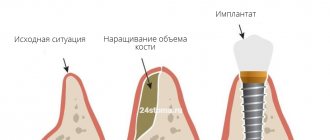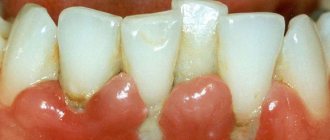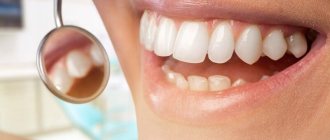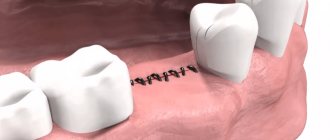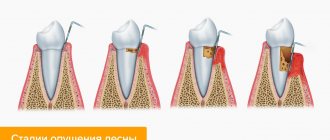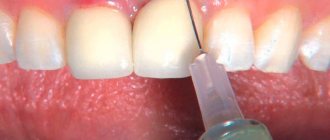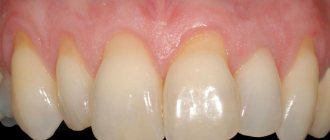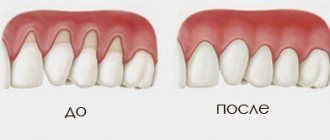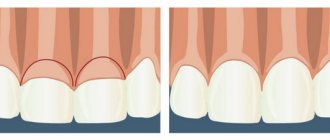From this article you will learn:
- Indications
- Contraindications
- How is gingivoplasty performed?
- Rehabilitation after gum surgery
- Complications after gum surgery
- How much does gum surgery cost?
Gingivoplasty is a surgical method for correcting, restoring or changing the gingival contour. The operation is performed on the mucous membrane, but may also include elements of bone grafting of the gums, if necessary.
Plastic surgery of soft gum tissue helps to get rid of a number of medical and aesthetic problems. Gingivoplasty is performed on the gums of both jaws, both over the entire length of the dentition and in the area of an individual tooth, depending on the indications and wishes of the patient. Therefore, the price of gum surgery can be radically different - this determines the volume and complexity of the intervention performed.
Indications for gum surgery
Surgical operations on the gums are indicated for pathologies of periodontal tissue caused by congenital anomalies, inflammatory processes or mechanical trauma.
- Gummy smile Exposing mostly the gums rather than the teeth when smiling. It is caused by the gingival tissue covering part of the crowns due to under-eruption of teeth; the teeth appear too short.
- Gum recession and exposure of tooth roots Resorption of soft tissues due to dental trauma, congenital features, long-term orthodontic treatment, excessive plaque accumulation. Teeth look too long.
- Gingival hypertrophy An abnormal growth of gingival tissue associated with genetic pathology or developed against the background of an inflammatory process.
- Inflammation of gum pockets Formation of periodontal pockets, accumulation of dental plaque due to poor hygiene, malocclusion, gum disease.
- Formation of a gingival hood Inflammation of the gums over the unerupted part of the crown of a wisdom tooth due to its difficult growth.
- Short frenulum of the lips or tongue Congenital defects in the development of the fold of mucous membrane connecting the lips to the gums or the tongue to the floor of the mouth.
A separate type of indication is associated with the correction of the gum line before tooth restoration:
- Before prosthetics Required in cases of gum loss, unequal volume in different parts of the jaw, small height of the teeth, the presence of periodontal pockets and detachment of the mucous membrane from the surface of the teeth.
- Before and after installation of implants Surgical correction of the soft tissues of the gums before implantation - in the case of bone grafting, after installation of the implant - in order to form an aesthetic gingival contour.
How is gingivoplasty performed?
The procedure can complete the flap operation by creating a properly shaped gum margin. To do this, existing defects are covered with periodontal flaps. The intervention can be carried out separately (when the gums are completely healed after surgery or as an independent procedure). Its volume can be different: for the gingival margin along the entire dentition or in areas corresponding to individual teeth (if local defects need to be removed).
During gingivoplasty, three main manipulations can be performed:
- cleaning the periodontal pocket from soft plaque and hard deposits;
- contouring of the gingival margin (resection of excess soft tissue);
- gum plastic (restoration of their normal volume at the expense of neighboring sections).
The surgeon can work with different types of tissue flaps:
- complete - consist of epithelium, periosteum, connective tissue;
- split - only from epithelium and connective tissue;
- simple - after intervention they return to their original place;
- positional - moved during the procedure if in one of the areas it is necessary to restore the original volume of gum tissue after recession or injury.
Stages of gingivoplasty:
- anesthesia. Sedation or anesthesia is usually not necessary; local anesthesia is sufficient. The volume of intervention is small, the procedure is carried out quickly, so the same anesthesia is often used as for dental treatment;
- processing of the surgical field. The area of the gums for which excision or plastic surgery will be performed is treated with antiseptic solutions;
- flap formation. To do this, several incisions are made in different directions to obtain an internal and superficial flap. They are carefully peeled off;
- cleaning Plaque and tartar are removed from the open periodontal pocket, and the root part of the tooth is cleaned. The procedure is similar to standard curettage;
- the internal flap is returned to its place, its size and shape are adjusted, and then it is covered with an external flap (can also be adjusted);
- the incisions are sutured to fix the outer flap in the correct position.
During gingivoplasty, the installation of bone blocks and protective membranes can be performed if the patient needs restoration of the normal volume of bone tissue after its destruction.
Types of gum surgery
The type of plastic surgery is determined by the doctor depending on the indications and condition of the gums, as well as the intended purpose.
Gum augmentation
Methods are used that restore gum volume when it is deficient.
- Vestibuloplasty An operation to deepen the vestibule of the oral cavity by increasing the volume of fixed gums that are too tightly fused with the muscles of the lips, cheeks or tongue. It is used if the tension of the facial muscles during speech communication and the process of chewing chronically injures the attached gum, which leads to its recession, the formation of periodontal pockets and exposure of tooth roots.
- Frenuloplasty The procedure of cutting the frenulum of the lips or tongue. It is used for congenital pathologies of the development of the frenulum, which provoke the appearance of a gap between the front incisors, the formation of gum pockets, excessive accumulation of dental plaque, gum disease, and exposure of tooth roots.
- Application of grafts Surgery to close gum recession by moving donor flaps from other parts of the oral cavity (gums, hard palate). In rare cases, it is possible to use special collagen membranes, which trigger the process of natural regeneration of the damaged area, but this option is not suitable for all patients.
Reducing the volume
An operation is performed - gingivectomy. This is the surgical excision of overgrown gum tissue during hypertrophy.
Helps reduce periodontal pockets, slows down the progression of gum disease if the pathology is caused by an inflammatory process.
After removing excess mucous membrane, an aesthetic gum contour is formed. Elimination of inflammation
Techniques are used aimed at eliminating inflammatory processes.
- Flap surgery is a surgical method for the treatment of moderate and severe periodontitis, aimed at reducing periodontal pockets, removing affected gum tissue and tooth roots, and restoring periodontal disease. During the operation, the gum is cut and peeled off, a flap of mucous membrane is formed, which, after removing the affected structures, is fixed in the desired position. If the flap volume is insufficient, a graft from another part of the oral cavity can be used.
- Excision of the gingival hood Pericoronarotomy is an operation to remove the overhanging inflamed gum over the erupting wisdom tooth. In the case of a purulent form of the disease, the gums are first dissected and anti-inflammatory therapy is carried out. After stopping the acute phase of inflammation, the hood is completely excised.
Only an experienced specialist can choose the most effective method for a specific clinical case, taking into account the type of gum pathology, the causes of development and the characteristics of the patient’s dental system as a whole. This requires certain knowledge, which ordinary dental surgeons who remove teeth do not always possess.
In our Center, gum surgeries of any degree of complexity are performed daily by experienced periodontists or maxillofacial surgeons with over 6 years of experience, deep theoretical knowledge and refined manual skills.
Medvedeva Tatyana Alexandrovna
Dentist-periodontist, 6 years of experience
Specialist in the diagnosis and treatment of gum diseases. Conservative, surgical, regenerative treatment. Microsurgical operations without pain under sedation.
More about the doctor
Indications
Gingivoplasty refers to aesthetic surgeries performed at the request of the patient for cosmetic purposes. But in a number of clinical situations, gum surgery is prescribed by a doctor for medicinal purposes. Main indications:
- inflammatory periodontal diseases, accompanied by the formation of periodontal pockets (periodontitis, hypertrophic gingivitis);
- gum pathologies, in which gum atrophy is observed (periodontal disease, fibromatosis, benign tumor-like neoplasms);
- gum augmentation during implantation to prevent rejection of the artificial root;
- hypertrophy of soft periodontal tissues;
- congenital frenulum defects;
- traumatic damage to the gums;
- age-related dystrophic changes in the gums;
- abnormalities in the development of the gingival margin (“gummy smile”, crooked contour).
Preparing for gum surgery
Diagnostics
Any operation is planned based on the results of the examination. In order to choose the right method for gum correction, the periodontist conducts a visual and instrumental examination. Computed tomography allows you to obtain more detailed information about the condition of the jaw structures.
Sanitation of the oral cavity
An important point before surgery is to ensure aseptic conditions in the oral cavity to avoid infection. Therefore, before the operation, sanitation (removal of caries, removal of diseased teeth that cannot be treated) and professional hygiene are required.
Excluding the causes of the disease
If a patient is diagnosed with bite problems, consultation and treatment with an orthodontist may be required, since these pathologies are one of the main causes of gum disease.
If the gingival contour is disrupted due to a traumatic factor with crowns or dentures, it is necessary to replace the orthopedic structures.
Operation stages
- Anesthesia Local anesthesia is used, which eliminates pain and discomfort. If the patient wishes, sedation can be used.
- Operation Performed according to the procedure. Gum tissue is excised, augmented or moved, depending on the type of pathology.
- Suturing The operated area is treated with anti-inflammatory drugs, and sutures are placed using the finest threads.
The duration of gingivoplasty depends on the chosen technique, and can range from twenty minutes to several hours. Surgical sutures are removed after 10-14 days.
Surgical treatment of gums should be as gentle as possible
In our Center, all mucogingival operations are performed under the optical magnification of a Seiler dental microscope. Allows the use of special microtools and the finest suture material. This ensures a reduction in rehabilitation time and an impeccable cosmetic effect.
Levin Dmitry Valerievich Chief physician and founder of the Doctor Levin center
Why is it better to do gingivoplasty “in your sleep”?
If the patient is very afraid and worried about the upcoming operation, we suggest performing it under sedation. This is an immersion into a state of light sleep with the help of safe sleeping pills under the supervision of our experienced anesthesiologist.
Sleep therapy provides:
- Maximum comfort A person does not feel pain or experience emotional stress. Awakening is, as usual, quick and easy.
- High-quality treatment The doctor is 100% focused on the operation, eliminating the possibility of inaccurate actions due to random movements of the patient.
- Risk prevention The patient is not worried, the blood pressure is normal, the risk of bleeding, and therefore the formation of edema and hematomas, is lower.
- Improved healing There is no release of stress hormone, which reduces the immunological status and slows down the regeneration processes.
How long does it take for gums to heal after surgery?
It may take 12-15 days for the gums to fully recover. Physiotherapeutic procedures will help speed up the process. They improve lymphatic drainage, reduce swelling, stimulate microcirculation, and accelerate tissue regeneration by normalizing trophism and gas exchange. For these purposes, the following physical methods are used:
- DENS (dynamic electrical neurostimulation);
- UHF;
- laser treatment;
- magnetotherapy.
If the surgeon’s recommendations are not followed, undesirable complications may occur:
- suture dehiscence, bleeding;
- addition of infection;
- tissue swelling;
- exacerbation of periodontitis;
- sepsis, etc.
Recovery after plastic surgery
Rehabilitation after gingivoplasty takes from 5 to 20 days, depending on the volume of surgical procedures performed and the individual characteristics of the body. In the first 3 days, swelling and soreness of the gums and adjacent areas may normally be observed. Gradually, the unpleasant symptoms will go away on their own.
Accelerated rehabilitation complex
Especially for patients who, due to a busy work schedule, cannot afford to stay at home for several days until postoperative unpleasant symptoms go away on their own, we have developed a unique accelerated rehabilitation program. With its help, recovery is reduced to 1-2 days.
Home care
In the postoperative period, in order to avoid complications, it is important to follow the doctor’s recommendations and strictly follow the instructions:
- Careful oral hygiene (do not touch the wound surface while brushing your teeth)
- Exclusion from the diet of foods that irritate the mucous membrane (spicy, salty, sour, too hot and cold, hard)
- Stop smoking on the first day after surgery, optimally for the entire rehabilitation period (nicotine slows down the regeneration process and increases the risk of complications)
- During the entire rehabilitation period, physical activity, flying, diving, and off-road driving are prohibited.
- Performing oral baths using antiseptic solutions
- Taking antibacterial and other drugs (only as prescribed by a doctor)
Our periodontist selects the medications necessary for recovery individually for each patient.
In case of any suspicious issues (bleeding, enlargement of the operated gum, pain, fever), please do not self-medicate, but contact the clinic. The patient support service is available 24 hours a day.
Postoperative period
After gingivoplasty, some side effects are possible - swelling, redness, increased tooth sensitivity. For quick rehabilitation and the absence of complications, you must follow the surgeon’s recommendations and regularly come to the clinic for examination.
For several days after the operation, it is advisable to follow the following recommendations:
- Rinse your mouth regularly and brush your teeth very carefully;
- Give up bad habits: smoking can lead to inflammation of injured tissues;
- Follow the diet: eat soft foods, avoid very hot or cold foods;
- Do not expose yourself to physical stress.
Thus, having more carefully understood what gingivoplasty is, it becomes clear that this is a simple, but at the same time very effective operation.
What determines the cost of the operation?
The cost of gingivoplasty depends on the chosen method and the extent of surgical intervention.
Any, even the most advanced situation on the gums can be corrected and made better and more beautiful. But in some situations, previously performed procedures complicate the process of rehabilitation with old scars.
All types of gingival margin reconstruction directly depend on the gum biotype. The thicker the gingival contour, the cheaper and simpler the treatment. If the gums are of the ultra-thin biotype, any surgical treatment will be a challenge for the patient and the doctor.

